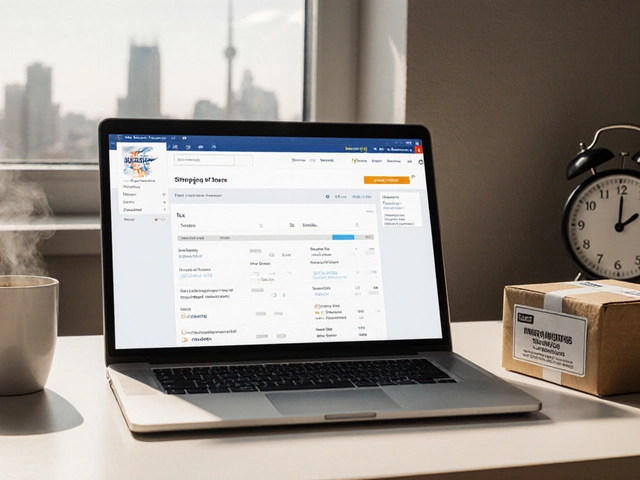Diving into the realm of Amazon pallets can feel like opening Pandora's box—complex yet intriguing. While these large shipments represent a practical solution for moving quantities of products, their pricing isn't a straightforward affair. A variety of components like size, delivery distance, and even weight can turn the cost wheel. But worry not, this article aims to untangle those mysteries.
By piecing together the critical elements that contribute to the cost, we hope to provide you with a clearer picture. From deciphering the pallet's purpose to understanding its journey across regions, we'll explore how each factor plays a role in determining what you might end up paying. Additionally, a few handy tips on saving some bucks when dealing with pallet deliveries are tucked in, ready for you to use. Whether it's for your business or personal use, knowing these details could save you not just money but also potential headaches down the road.
- Understanding Amazon Pallets
- Factors Determining Cost
- Tips for Saving on Delivery
- Using Amazon Pallets for Business
Understanding Amazon Pallets
Amazon pallets stand as a backbone in the logistics world, largely unseen but certainly felt across many sectors. But what exactly are they, and how do they work within the giant ecosystem that is Amazon? These pallets are robust structures designed to hold numerous shipping boxes or products, streamlining the transport process substantially. While not glamorous, they are indispensable in ensuring that products get from the warehouse's bustling aisles to the homes or businesses eagerly awaiting their delivery. A typical Amazon pallet is made from wood, although plastic and metal variants exist, offering greater durability and resistance to weather conditions. With a standard size usually set at 48 inches by 40 inches, these pallets feature a grid-like top surface, providing a stable base for products to be stacked during shipment.
What makes an Amazon pallet unique is not just its physical attributes but its role in the intricate logistics dance orchestrated daily around the globe. Pallets help in reducing handling time and related costs, making the shipping process far more efficient. These advantages are largely derived from their ability to standardize the shipping unit, combining multiple packages into a single, manageable load, which simplifies storage and space optimization in warehouses. Notably, this mechanism reduces the chances of shipping errors, a nod to the precision Amazon is known for. The sheer volume of products that Amazon handles on a regular basis necessitates such a system. In fact, reports indicate that Amazon ships over 1.6 million orders daily, underscoring the mammoth task of coordinating such logistics.
Understanding how these pallets integrate into the Amazon supply chain provides a clearer picture of why they are essential. As part of its strategy, Amazon meticulously organizes products into pallets at its fulfillment centers. This organization is pivotal because it allows Amazon to efficiently utilize its transport assets from trucks to aircraft, ensuring timely deliveries. Furthermore, knowing how to handle and utilize these pallets can be a game-changer for businesses that partner with Amazon. They become more aligned with Amazon's logistical methods, ensuring a smoother collaboration. Interestingly, insights drawn from the loading and unloading efficiency of pallets have even influenced how Amazon designs its warehouses and distribution networks.
Another often overlooked aspect is the sustainability impact of Amazon pallets. Given that pallets are reused repeatedly before they're retired, they contribute significantly to reducing waste in logistics operations. According to a study by Virginia Tech, pallets are recycled at a rate of about 95%, highlighting their environmental benefits over single-use packaging methods. Companies that align with these greener practices, such as Amazon, benefit from both cost savings and improved corporate responsibility profiles. This has a broader implication, influencing supply chain practices across the industry as environmental concerns take center stage. A 2022 survey revealed that sustainability is becoming a major factor in company logistics decisions, with an increasing trend towards recycling and reducing carbon footprints.
"In modern logistics, the pallet is not just a carrier; it's a critical component of efficiency and sustainability," said logistics expert John Smith.
When delving into the world of Amazon pallets, one quickly realizes that these are not just simple wooden squares but a crucial, complex component of a massive, well-oiled machine. Whether you're in the business of logistics or simply an Amazon consumer curious about what goes on behind the scenes, understanding the role of pallets gives insight into a critical aspect of efficient modern supply chains.

Factors Determining Cost
Navigating through the intricacies of pallet delivery can sometimes feel like solving a jigsaw puzzle. The cost involved in shipping an Amazon pallet hinges on several critical variables. First up, the physical dimensions and weight of the pallet take center stage. It's no surprise that a larger, heavier pallet will command a higher price due to the added complexity in handling and transportation. The heavier the load, the more fuel it requires, translating directly into your invoice. In addition to the bare heft of the goods, special handling requests—such as temperature control for perishables—can significantly crank up costs.
Location is another game-changer. The distance from the point of origin to the destination deeply impacts the transport expenses. Typically, longer distances equal higher costs due to increased fuel consumption and time investment. Urban versus rural destinations can also influence expenses, as delivery trucks navigating through bustling city streets versus remote areas may require variable logistics support. The availability of courier services and their proximity to both the source and destination can lead to stark cost differences.
Time and Speed Demands
The time factor plays an undeniable role, too. If you find yourself in a crunch, requiring expedited delivery, be prepared for heightened charges. Express deliveries are prioritized and involve a rapid maneuver of resources; hence, they're priced competitively. Regular shipping timelines, while generally more affordable, are slower and might not suit every urgency. For time-bound shipments, one must weigh the cost against the urgency to find a sensible middle path.Shipping regulations specific to certain regions or countries can also tweak the cost. Regulations can determine the protocol for loading, unloading, or specific packaging standards, which might incur added costs if non-standard items are involved. For international deliveries, customs, taxes, and duties enter the equation as well. "In many cases, hidden costs associated with customs can make a significant dent in the budget," as noted by a logistics analyst at Freightos.
Sometimes the devil lies in the smaller details, such as insurance coverage. An optional, yet wise, choice is insuring valuable or sensitive shipments. The cost of insuring Amazon pallets varies based on the pallet's declared value and its content risk profile. While it adds to the upfront cost, it acts as a safety net against potential losses or damage. Strategizing around aggregation—pooling shipments within a company or alongside other businesses—can reduce costs through shared resources and bulk rates offered by courier services.
Carrier and Service Selection
Lastly, the choice of carrier or shipping service plays a vital role. Different carriers offer tiered pricing based on service types, delivery speed, or coverage area. There's room for negotiation with some services if you have a regular shipping volume or can commit to long-term contracts. Keeping abreast of promotions or discounts is another way to trim costs, especially during off-peak seasons when shipments drop and carriers are eager for business. Weighing up these aspects will provide a better understanding of the component-based pallet pricing structure.
Tips for Saving on Delivery
Getting your goods shipped efficiently while keeping costs down is a priority for many businesses and individuals alike. When it comes to shipping an Amazon pallet, there are several strategies that can help you save a few dollars. One of the simplest ways is to plan and consolidate shipments. By arranging for multiple orders to be delivered on a single pallet, you're reducing the frequency and cost of shipments. This not only cuts down on per-pallet charges but also means you're minimizing the logistics involved per batch of goods. Many industries have noted that effective shipment grouping can lead to savings of up to 30% on logistics costs.
Moreover, being flexible with your delivery dates might just be the ticket to more affordable freight costs. Many carriers offer discounts for shipping on off-peak days. This flexibility allows for more efficient routing and sometimes quicker delivery since carriers can optimize their load management. By discussing your delivery window with the carrier, you may find a more budget-friendly solution without compromising on time.
Another essential aspect to consider is the negotiated rate. If you're a regular shipper, it's wise to discuss long-term contracts with your courier service provider. Companies such as FedEx and UPS, along with smaller freight companies, often provide discounted rates for those willing to commit to repeating contracts. A commitment to ship a particular volume each month can secure a lower cost-per-pallet, making it a valuable consideration for budget-conscious businesses. A logistics manager remarks,
"Building a stable relationship with your delivery service extends beyond saving money; it creates trust and reliability over time."
Additionally, investing in insurance might not seem like a direct way to save money, but consider the potential for unforeseen costs if items are damaged during transit. By insuring your shipment, especially valuable or fragile items, you're protecting yourself from compensating for those losses out of pocket. While there's a cost involved in securing coverage, the potential savings from avoided damages often justify this expense.
Finally, optimizing your pallet packing can prevent damages and unnecessary costs. Ensuring that your goods are packed tightly and securely not only keeps them safe but reduces the need for additional pallets. This involves using materials such as shrink wrap and corner protectors to keep your products intact. Mislabeled or poorly packed pallets can result in delays and additional fees. Taking extra care in this step saves money and buys peace of mind.

Using Amazon Pallets for Business
In the bustling world of commerce, leveraging Amazon pallets can be a game-changer for businesses aiming to streamline their logistics and cut down on costs. These massive stacks of goods, often used by large retailers and smaller ventures alike, serve as the backbone of efficient inventory management and transport. By utilizing pallets, companies can easily move bulk products, reducing the labor and time that handling individual items would otherwise require. This not only speeds up the supply chain but also minimizes potential damage to goods during transit, which is a significant concern for many.
Amazon offers a comprehensive service that includes pallet delivery, allowing businesses to tap into their vast network for distribution needs. The convenience of integrating with Amazon's logistical systems means that companies can focus on growth without being bogged down by shipping intricacies. Of course, the cost considerations are crucial. Often, economies of scale come into play, making shipping via a pallet more affordable per unit when compared to smaller shipments. This price efficiency highlights why understanding the ins and outs of pallet delivery is an essential skill for any business owner, regardless of size.
"Harnessing the power of pallet delivery can transform your business's operational efficiency," says James Carter, a logistics expert and consultant for several Fortune 500 companies. His words emphasize the strategic advantage businesses gain by optimizing their shipping channels through pallets.
Additionally, using Amazon pallets gives businesses access to a broad spectrum of shipping options that can adapt to varying demands. With the growth of eCommerce, flexibility is crucial. Businesses that can promptly respond to market demands position themselves better for success. Also, the durability and effectiveness of these pallets cannot be overstated. Whether a small business with big ambitions or a large corporation seeking efficiency, understanding the workings of Amazon's pallet system is invaluable. There’s a synergy between cost-saving and service quality in this whole setup, which supports business scalability and customer satisfaction.
Here's a quick look at the major benefits:
- Cost-effective bulk shipping that reduces per-item costs significantly.
- Integration with Amazon's advanced logistical networks, improving delivery times and reliability.
- Reduced manual handling, minimizing the risk of damage to goods.
- Increased operational efficiency, allowing businesses to redirect resources to core activities.
| Year | Percentage of Businesses Using Pallets |
|---|---|
| 2020 | 62% |
| 2023 | 78% |
Statistics suggest that more businesses are gravitating towards pallet use each year. As commerce moves rapidly towards more online solutions, the importance of efficient shipping methods like pallets will only grow. Businesses which learn and adapt now will not just survive but thrive in this competitive landscape. All things considered, incorporating Amazon pallets into your business operations could very well be the secret ingredient to a recipe for unparalleled success.





